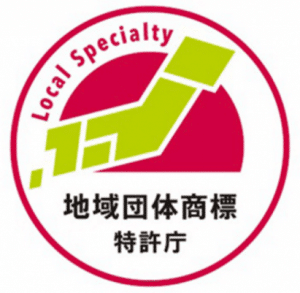In 2006, Japan introduced a program for trademarks that were collective (compare with US collective marks) and regional indications (compare with European RIs), the chiiki dantai shōhyō seido (地域団体商標制度). Translated as the Regional Collective Trademark (RCT) System, this arrangement seeks to promote enhanced awareness of and economic profit for products and services (often local cuisine, produce, or hot baths) around Japan.
The Japanese government has pushed the program and many regional organizations had registered about 680 such Regional Collective Trademarks with the JPO as of March 2020, reports the latest JPO annual administrative report (特許行政年次報告書 2020 年版). Regions with registered RCTs hope that these will boost sales and name recognition and protection against imitations and counterfeits from other countries.[2, p. 140-142; one recent example in source 4] It is not very difficult to find RCTs around Japan, particularly in rural areas. In fact, it is even possible to register a RCT for foreign goods and services, for promotion in Japan! [1 lists three current examples, from Italy, PRC, and Sri Lanka.]Does the Regional Collective Trademark system actually work? A skeptical article in 2015 by Kenneth L. Port questioned the real economic benefit of the system, and proposed that the program has been used to pay lip service to regionalism in Japanese politics without giving demonstrable benefits.[3]
Some organizations, certainly, must benefit from the protection, especially if their goods or services are being counterfeited. For example, the JPO report recounts a compromising trademark registered in the People’s Republic of China that was used to imitate Kuki pottery in Ishikawa Prefecture, Japan [2, p. 142]. For many organizations in Japan, though, the motivation may be the desire to get on the intellectual property “bandwagon” of Japanese economic strategy and be in on the action with a trademark to showcase.
The system probably does give some minor influence upon Japanese domestic tourists, who are eager to find the local specialties. However, the vast majority of inbound tourists (before the novel coronavirus decimated tourism nationwide, that is) head for cities and are probably too satisfied with general Japanese culture to look very specifically for a unique pot of curry or hot bath according to trademark.
It is hard to say what the precise costs and benefits are for organizations and regions that use them, but the RCTs do demonstrate the pride people of rural Japan take in their local specialties, and the hopes they have to draw wealth from the swelling Tokyo and other urban centers to their villages and towns. Perhaps more exporters of regionally distinct products to Japan would find the registration system an attention-creating way to attract buyers even in Japan.
* The information provided on this website is for informational purposes only and is not intended as legal advice.
** For questions or consultation, please contact us for more information.
Taro Yaguchi.
[1] Japan Patent Office. “地域団体商標登録案件一覧 [List of registered regional collective trademarks].” Updated July 8, 2020. Accessed July 17, 2020.
[2] Japan Patent Office. 特許行政年次報告書 2020 年版 [JPO annual administrative report 2020]. Updated July 14, 2020. Trademarks section: https://www.jpo.go.jp/resources/report/nenji/2020/document/index/honpen0203.pdf Accessed July 17, 2020.
[3] Port, Kenneth L. “Regionally Based Collective Trademark System in Japan: Geographical Indicators by a Different Name or a Political Misdirection?,” Cybaris®: Vol. 6: Iss. 2, Article 2 (2015). Available at: http://open.mitchellhamline.edu/cybaris/vol6/iss2/2 Accessed July 17, 2020.
[4] Saga Shimbun Live. “「女山大根」商標登録 地域団体商標制度の県内8件目 多久市 ブランド保護、消費拡大へ [“Onnayama Daikon” radish trademark registered; eighth regional collective trademark registered in prefecture, Taku City].” https://www.saga-s.co.jp/articles/-/544470 July 7, 2020. Accessed July 17, 2020.
Image credits:
Japan Patent Office’s Regional Collective Trademark logo, https://www.jpo.go.jp/system/trademark/gaiyo/chidan/mark.html. Permission granted to use for news outlets.
Top Image (of non-specific Japanese lacquerware) by umehanayuuki from Pixabay.







